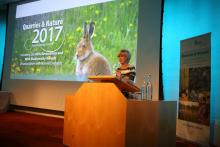A multi-million euro project to turn quarries into wildlife havens has been hailed by conservationists as a vital lifeline for nature.
Restore, a project financed by the EU's Interreg IVB North-West Europe fund, will see €3.3 million spent on creating priority habitats, turning spent mineral extraction sites into reed beds, meadows, woodlands, and heathland. The extra funding comes as a host of sites across the UK have recently recorded species bouncing back as a result of restoration work.
A variety of insects, crayfish, otters and bitterns are just some of the species that are thriving in newly-created habitats and the new funding means conservationists and the minerals industry can do even more for wildlife in the future.
The recent State of Nature report, launched by broadcaster and naturalist Sir David Attenborough, and 25 leading nature organisations revealed that 60% of UK species are in decline. Loss of natural habitat was singled out as one of the biggest causes.
Martin Harper, RSPB (
“In recent years the minerals industry and conservationists have forged a vital link and we have seen some truly inspiring work happen as a result. I have walked through wildlife havens alive with birds, butterflies and wild flowers where once there were diggers, excavations and conveyor belts. These transformations show that with the right expertise and dedication it is possible to bring wildlife back to our countryside, for all to enjoy.
“This money and the project it will support are vital if we are to carry that work on. I want to say thanks to the minerals industry for all that they have done for our wildlife so far, and I want to challenge them to go even further so we can turn even more of these sites around.”
Conservation successes on quarry sites include the recording of a rare spider-eating wasp, identified for the first time in England at the LafargeTarmac Sandy Heath quarry in County Bedfordshire, England.
Numbers of breeding great crested newts are at record levels at ponds specifically created at Ryder Point quarry in Matlock, County Derbyshire, worked by independent operator Longcliffe Quarries and a member of the
Acknowledging this success, Peter Huxtable, BAA Secretary, said: “Our members are endeavouring to do their bit for nature. They recognise the great potential to create homes for nature on their sites.”
Ouse Fen in County Cambridgeshire, a nature reserve being created from a
At Kemerton Lake in County Worcestershire, a former sand and gravel extraction site, native white-clawed crayfish have been reintroduced by Buglife, the Invertebrate Conservation Trust. More are set to be released into the lake this summer to help the species which has been decimated by the influx of invasive American crayfish in our lakes and rivers.
The summer has also seen increased sightings of the threatened small blue and grizzled skipper butterflies at restored
Nigel Jackson, chief executive of the
“Together, we can help reverse the decline in biodiversity by creating priority habitat and providing vital footholds for endangered species. The minerals industry is in a unique position to be able to make a difference.”
The Restore project will see the RSPB, Surrey County Council and five other partners from across north-west Europe coming together to work collaboratively and invest in demonstration sites that show what can be achieved for nature through appropriate and sustainable quarry restoration.
A new online interactive map will be created to help the minerals sector plan restorations within the context of neighbouring nature conservation designated areas.
The scheme will also help local planning authorities develop better policies to encourage restoration for biodiversity and the project will be officially launched at a reception at the Institute of Materials, Minerals & Mining in London on 25 September.









